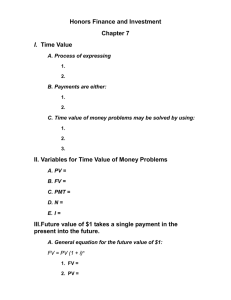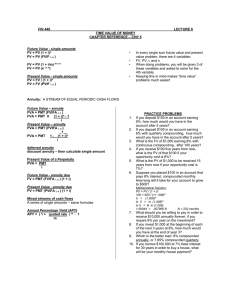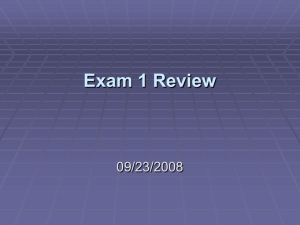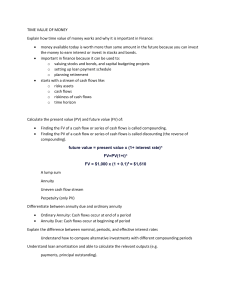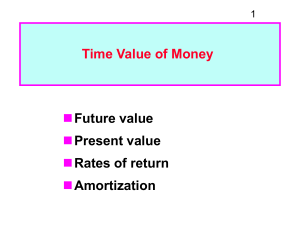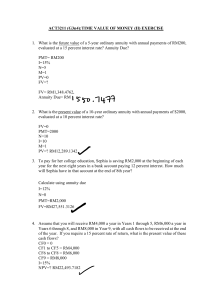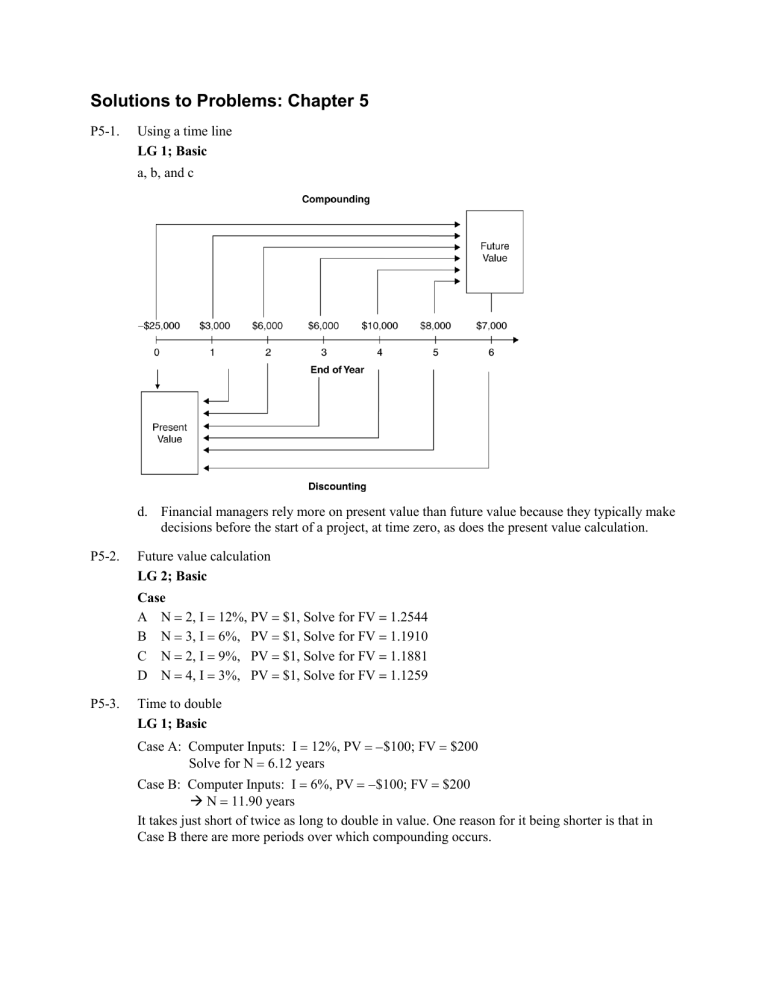
Solutions to Problems: Chapter 5 P5-1. Using a time line LG 1; Basic a, b, and c d. Financial managers rely more on present value than future value because they typically make decisions before the start of a project, at time zero, as does the present value calculation. P5-2. Future value calculation LG 2; Basic Case A N B N C N D N P5-3. 2, I 3, I 2, I 4, I 12%, PV 6%, PV 9%, PV 3%, PV $1, Solve for FV $1, Solve for FV $1, Solve for FV $1, Solve for FV 1.2544 1.1910 1.1881 1.1259 Time to double LG 1; Basic Case A: Computer Inputs: I 12%, PV $100; FV $200 Solve for N 6.12 years Case B: Computer Inputs: I 6%, PV $100; FV $200 N 11.90 years It takes just short of twice as long to double in value. One reason for it being shorter is that in Case B there are more periods over which compounding occurs. Note: You could use the ―Rule of 72‖ to complete the problem. Simply divide 72 by the interest rate to get the number of years it would take to double an initial balance. P5-4. P5-5. Case A: 72 12 6 years Case B: 72 6 12 years Future values LG 2; Intermediate Case A N 20, I 5%, PV $200. Solve for FV $530.66 C N 10; I 9%; PV $10,000. Solve for FV $23,673.64 Case B N 7, I/Y 8%; PV $4500. Solve for FV $7,712.21 D N 12; I 10%, PV $25,000 Solve for FV $78,460.71 E F N 5, I 11, PV $37,000 Solve for FV $62,347.15 N 9, I 12, PV $40,000 Solve for FV $110,923.15 Personal finance: Time value LG 2; Intermediate a. c. (1) N 3, I 7%, PV $1,500 Solve for FV3 $1,837.56 b. (1) Interest earned Interest earned FV3 PV $1,837.56 $1,500.00 $337.56 (2) N 6, I 7%, PV $1,500 (2) Interest earned FV6 – FV3 Solve for FV6 $2,251.10 Interest earned $2,251.10 –$1,837.56 $413.54 (3) N 9, I 7%, PV $1,500 (3) Interest earned FV9 FV6 Solve for FV9 $2,757.69 Interest earned $2,757.69 –$2,251.10 $506.59 The fact that the longer the investment period is, the larger the total amount of interest collected will be, is not unexpected and is due to the greater length of time that the principal sum of $1,500 is invested. The most significant point is that the incremental interest earned per 3-year period increases with each subsequent 3-year period. The total interest for the first 3 years is $337.56; however, for the second 3 years (from year 3 to 6) the additional interest earned is $413.54. For the third 3-year period, the incremental interest is $506.59. This increasing change in interest earned is due to compounding, the earning of interest on previous interest earned. The greater the previous interest earned, the greater the impact of compounding. P5-6. Personal finance: Time value LG 2; Challenge a. (1) N 5, I 2%, PV $14,000 (2) N 5, I 4%, PV $14,000 Solve for FV $15,457.13 Solve for FV $17,033.14 b. The car will cost $1,576.01 more with a 4% inflation rate than an inflation rate of 2%. This increase is 10.2% more ($1,576 $15,457) than would be paid with only a 2% rate of inflation. c. Future value at end of first 2 years: N 2, I 2%, PV $14,000 Solve for FV2 $14,565.60 Price rise at end of 5th year: N 3, I 4%, PV $14,565.60 Solve for FV5 $16,384.32 As one would expect, the forecast price is between the values calculated with 2% and 4% interest. P5-7. Personal finance: Time value LG 2; Challenge Deposit Now: Deposit in 10 Years: N 40, I 9%, PV $10,000 Solve for FV $314,094.20 N 30, I 9%, PV $10,000 Solve for FV $132,676.78 You would be better off by $181,417 ($314,094 $132,677) by investing the $10,000 now instead of waiting for 10 years to make the investment. P5-8. Personal finance: Time value LG 2; Challenge a. c. P5-9. N 5, PV Solve for I N 5, PV Solve for I $10,200, FV 15,000 8.02% $7150, FV $15,000 15.97% b. N 5, PV Solve for I $8,150, FV 12.98% Personal finance: Single-payment loan repayment LG 2; Intermediate a. c. N 1, I 14%, PV $200 Solve for FV1 $228 N 8, I 14%, PV $200 Solve for FV8 $570.52 b. N 4, I 14%, PV $200 Solve for FV4 $337.79 $15,000 P5-10. Present value calculation: PVIF 1 (1 i )n LG 2; Basic Case A B C D N N N N 4, I 2, I 3, I 2, I 2, FV 10, FV 5, FV 13, FV $1.00, Solve for PV $1.00, Solve for PV $1.00, Solve for PV $1.00, Solve for PV $0.9238 $0.8264 $0.8638 $0.7831 P5-11. Present values LG 2; Basic Case A B C D E PV N N N N N 4, 20, 12, 6, 8, I I I I I 12%, 8%, 14%, 11%, 20%, FV FV FV FV FV $7,000 $28,000 $10,000 $150,000 $45,000 $4,448.63 $6,007.35 $2,075.59 $80,196.13 $10,465.56 P5-12. Present value concept LG 2; Intermediate a. N 6, I 12%, FV $6,000 b. N 6, I 12%, FV $6,000 Solve for PV $3,039.79 Solve for PV $3,039.79 c. N 6, I 12%, FV $6,000 Solve for PV $3,039.79 d. The answer to all three parts is the same. In each case the same question is being asked but in a different way. P5-13. Personal finance: Time Value LG 2; Basic a. N 3, I 7%, FV $500 Solve for PV $408.15 b. Jim should be willing to pay no more than $408.15 for this future sum given that his opportunity cost is 7%. c. If Jim pays less then 408.15, his rate of return will exceed 7%. P5-14. Time value: Present value of a lump sum LG 2; Intermediate I 6, I 8, FV $100 Solve for PV $63.02 P5-15. Personal finance: Time value and discount rates LG 2; Intermediate a. b. c. (1) N 10, I 6%, FV $1,000,000 Solve for PV $558,394.78 (3) N 10, I 12%, FV $1,000,000 Solve for PV $321,973.24 (2) N 10, I 9%, FV $1,000,000 Solve for PV $422,410.81 (1) N 15, I 6%, FV $1,000,000 (2) N 15, I 9%, FV $1,000,000 Solve for PV $417,265.06 Solve for PV $274,538.04 (3) N 15, I 12%, FV $1,000,000 Solve for PV $182,696.26 As the discount rate increases, the present value becomes smaller. This decrease is due to the higher opportunity cost associated with the higher rate. Also, the longer the time until the lottery payment is collected, the less the present value due to the greater time over which the opportunity cost applies. In other words, the larger the discount rate and the longer the time until the money is received, the smaller will be the present value of a future payment. P5-16. Personal finance: Time value comparisons of lump sums LG 2; Intermediate a. A N 3, I 11%, FV $28,500 B N 9, I 11%, FV $54,000 Solve for PV $20,838.95 Solve for PV $21,109.94 C N 20, I 11%, FV $160,000 Solve for PV $19,845.43 b. Alternatives A and B are both worth greater than $20,000 in term of the present value. c. The best alternative is B because the present value of B is larger than either A or C and is also greater than the $20,000 offer. P5-17. Personal finance: Cash flow investment decision LG 2; Intermediate A N 5, I 10%, FV $30,000 Solve for PV $18,627.64 C N 10, I 10%, FV $10,000 Solve for PV $3,855.43 Purchase B N 20, I 10%, FV $3,000 Solve for PV $445.93 D N 40, I 10%, FV $15,000 Solve for PV $331.42 Do Not Purchase A B C D P5-18. Calculating deposit needed LG 2; Challenge Step 1: Determination of future value of initial investment N 7, I 5%, PV $10,000 Solve for FV $14,071.00 Step 2: Determination of future value of second investment $20,000 $14,071 $5,929 Step 3: Calculation of initial investment N 4, I 5%, FV $5,929 Solve for PV $4877.80 P5-19. Future value of an annuity LG 3; Intermediate a. Future value of an ordinary annuity vs. annuity due (1) Ordinary Annuity (2) Annuity Due A N 10, I 8%, PMT $2,500 $36,216.41 1.08 Solve for FV $36,216.41 B N 6, I 12%, PMT $500 Solve for FV $4,057.59 $4,057.59 1.12 $39,113.72 $4,544.51 C N 5, I 20%, PMT $30,000 $223,248 1.20 $267,897.60 Solve for FV $223,248 D N 8, I 9%, PMT $11,500 $126,827.47 1.09 $138,241.92 Solve for FV $126,827.45 E N 30, I 14%, PMT $6,000 $2,140,721.08 1.14 $2,440,442/03 Solve for FV $2,140,721.08 b. The annuity due results in a greater future value in each case. By depositing the payment at the beginning rather than at the end of the year, it has one additional year of compounding. P5-20. Present value of an annuity LG 3; Intermediate a. Present value of an ordinary annuity vs. annuity due (1) Ordinary Annuity (2) Annuity Due A N 3, I 7%, PMT $12,000 $31,491.79 1.07 $33,696.22 Solve for PV $31,491,79 B N 15, I 12%, PMT $55,000 $374,597.55 1.12 $419,549.25 Solve for PV $374,597.55 C N 9, I 20%, PMT $700 $2,821.68 1.20 $3,386.02 Solve for PV $2,821.68 D N 7, I 5%, PMT $140,000 $810,092.28 1.05 $850,596.89 Solve for PV $810,092.28 E N 5, I 10%, PMT $22,500 $85,292.70 1.1 $93,821.97 Solve for PV $85,292.70 b. The annuity due results in a greater present value in each case. By depositing the payment at the beginning rather than at the end of the year, it has one less year to discount back. P5-21. Personal finance: Time value—annuities LG 3; Challenge a. Annuity C (Ordinary) (1) N 10, I 10%, PMT $2,500 Solve for FV $39,843.56 Annuity D (Due) N 10, I 10%, PMT $2,200 Solve for FV $35,062.33 Annuity Due Adjustment $35,062.33 1.1 $38,568.57 (2) N 10, I 20%, PMT $2,500 N 10, I 20%, PMT $2,200 Solve for FV $64,896.71 Solve for FV $57,109.10 Annuity Due Adjustment $57,109.10 1.2 $68,530.92 b. (1) At the end of year 10, at a rate of 10%, Annuity C has a greater value ($39,843.56 vs. $38,568.57). (2) At the end of year 10, at a rate of 20%, Annuity D has a greater value ($68,530.92 vs. $64,896.71). c. Annuity C (Ordinary) Annuity D (Due) (1) N 10, I 10%, PMT $2,500 N 10, I 10%, PMT $2,200 Solve for PV $15,361.14 Solve for PV $13,518.05 Annuity Due Adjustment $13,518.05 1.1 $14,869.85 (2) N 10, I 20%, PMT $2,500 N 10, I 20%, PMT $2,200 Solve for PV $10.481.18 Solve for PV $9,223.44 Annuity Due Adjustment $9,223.44 1.2 $11,068.13 d. (1) At the beginning of the 10 years, at a rate of 10%, Annuity C has a greater value ($15,361.14 vs. $14,869.85). (2) At the beginning of the 10 years, at a rate of 20%, Annuity D has a greater value ($11,068.13 vs. $10,481.18). e. Annuity C, with an annual payment of $2,500 made at the end of the year, has a higher present value at 10% than Annuity D with an annual payment of $2,200 made at the beginning of the year. When the rate is increased to 20%, the shorter period of time to discount at the higher rate results in a larger value for Annuity D, despite the lower payment. P5-22. Personal finance: Retirement planning LG 3; Challenge a. N 40, I 10%, PMT $2,000 b. N 30, I 10%, PMT $2,000 Solve for FV $885,185.11 Solve for FV $328,988.05 c. By delaying the deposits by 10 years the total opportunity cost is $556,197. This difference is due to both the lost deposits of $20,000 ($2,000 10 years) and the lost compounding of interest on all of the money for 10 years. d. Annuity Due: N 40, I 10%, PMT $2,000 Solve for FV $885,185.11 Annuity Due Adjustment: $885,185.11 1.10 $973,703.62 N 30, I 10%, PMT $2,000 Solve for FV $328,988.05 Annuity Due Adjustment: $328,988.05 1.10 $361,886.85 Both deposits increased due to the extra year of compounding from the beginning-of-year deposits instead of the end-of-year deposits. However, the incremental change in the 40-year annuity is much larger than the incremental compounding on the 30-year deposit ($88,518 vs. $32,898) due to the larger sum on which the last year of compounding occurs. P5-23. Personal finance: Value of a retirement annuity LG 3; Intermediate N 25, I 9%, PMT $12,000 Solve for PV $117,870.96 P5-24. Personal finance: Funding your retirement LG 2, 3; Challenge a. c. N 30, I 11%, PMT $20,000 b. N 20, I 9%, FV $173.875.85 Solve for PV $173,875.85 Solve for PV $31,024.82 Both values would be lower. In other words, a smaller sum would be needed in 20 years for the annuity and a smaller amount would have to be put away today to accumulate the needed future sum. d. N 30, I 10%, PMT $20,000 b. N 20, I 10%, FV $188,538.29 Solve for PV $188,538.29 Solve for PV $28,025.02 More money will be required to support the $20,000 annuity in retirement, because the initial amount will earn 1% less per year. However, more less money will have to be deposited during the next 20 years, because the return on saved funds will be 1% higher. P5-25. Personal finance: Value of an annuity vs. a single amount LG 2, 3; Intermediate a. N 25, I 5%, PMT $40,000 Solve for PV $563,757.78 At 5%, taking the award as an annuity is better; the present value is $563,760, compared to receiving $500,000 as a lump sum. However, one has to live at least 23.5 years [25 – (63,757.78 excess/ $40,000)] to benefit more from the annuity stream of payments. b. N 25, I 7%, PMT $40,000 Solve for NPV $466,143.33 At 7%, taking the award as a lump sum is better; the present value of the annuity is only $466,160, compared to the $500,000 lump-sum payment. c. View this problem as an investment of $500,000 to get a 25-year annuity of $40,000. The discount rate that equates the two sums is 6.24%, calculated at follows: N 25, PV -$500,000, PMT Solve for I 6.24 $40,000 P5-26. Perpetuities LG 3; Basic Case Equation Value A $20,000 0.08 $250,000 B $100,000 0.10 $1,00,000 C $3,000 0.06 $50,000 D $60,000 0.05 $1,200,000 P5-27. Personal finance: Creating an endowment LG 3; Intermediate a. 6% interest rate ($600 3) 0.06 $30,000 b. 9% percent interest rate ($600 3) 0.09 $20,000 P5-28. Value of a mixed stream LG 4; Challenge a. Cash Flow Stream A Year Number of Years to Compound 1 2 3 2 1 0 Cash flow $ Interest Rate 900 1,000 1,200 Sum Future Value $ 1,128.96 1,120.00 1,200.00 $ 3,448.96 B 1 2 3 4 5 4 3 2 1 0 $30,000 25,000 20,000 10,000 5,000 $ 47,205.58 35,123.20 25,088.00 11,200.00 5,000.00 Sum $123,616.78 C 1 2 3 4 3 2 1 0 $ 1,200 1,200 1,000 1,900 $1,685.91 1,505.28 1,120.00 1,900.00 Sum $ 6,211.19 b. If payments are made at the beginning of each period the present value of each of the end-ofperiod cash flow streams will be multiplied by (1 i) to get the present value of the beginningof-period cash flows. A $3,448.96 (1 0.12) $ 3,862.83 B $123,616.78 (1 0.12) $138,450.79 C $6,211.19 (1 0.12) $ 6,956.53 P5-29. Personal finance: Value of a single amount vs. a mixed stream LG 4; Intermediate Lump-Sum Deposit N 5, I 7, PV $24,000 Solve for FV $33,661.24 Mixed Stream of Payments Beginning of Year Number of Years to Compound Cash Flow Interest Rate Future Value 5 4 3 2 1 $ 2,000 $ 4,000 $ 6,000 $ 8,000 $10,000 7% $ 2,805.10 $ 5,243.18 $ 7,350.25 $ 9,159.20 $10,700.00 $35,257.73 1 2 3 4 5 7% Sum Gina should select the stream of payments over the front-end lump sum payment. Her future wealth will be higher by $1,596.49. P5-30. Value of mixed stream LG 4; Basic Project A CF1 $2,000, CF2 $3,000, CF3 $4,000, CF4 $6,000, CF5 Set I 12 Solve for NPV $11,805.51 Project B CF1 $10,000, CF2 $5,000, F2 4, CF3 $7,000 Set I 12 Solve for NPV $26,034.58 Project C CF1 $10,000, F1 5, CF2 $8,000, C2 5 Set I 12 Solve for NPV $52,411.34 $8,000 P5-31. Present value—Mixed stream LG 4; Intermediate a. Stream A CF1 $50,000, CF2 $40,00, CF3 $30,000, CF4 $20,000, CF5 $10,000 Set I 15 Solve for NPV $109,856.33 Stream B CF1 $10,00, CF2 $20,000, CF3 $30,000, CF4 $40,000, CF5 $50,000 Set I 15 Solve for NPV $91,272.98 b. Cash flow stream A, with a present value of $109,890, is higher than cash flow stream B’s present value of $91,290 because the larger cash inflows occur in A in the early years when their present value is greater, while the smaller cash flows are received further in the future. P5-32. Value of a mixed stream LG 1, 4; Intermediate a. b. CF1 $30,000, CF2 $25,000, CF3 $15,000, F3 7, CF4 $10,000 Set I 12 Solve for NPV $104,508.28 c. Harte should accept the series of payments offer. The present value of that mixed stream of payments is greater than the $100,000 immediate payment. P5-33. Personal finance: Funding budget shortfalls LG 4; Intermediate a. CF1 $5,000, CF2 $4,000, CF3 $6,000, CF4 $10,000, CF5 $3,000 Set I 8 Solve for NPV $22,214.03 A deposit of $22,215 would be needed to fund the shortfall for the pattern shown in the table. b. An increase in the earnings rate would reduce the amount calculated in part a. The higher rate would lead to a larger interest income being earned each year on the investment. The larger interest amounts will permit a decrease in the initial investment to obtain the same future value available for covering the shortfall. P5-34. Relationship between future value and present value-mixed stream LG 4; Intermediate a. CF1 $800, CF2 $900, CF3 $1,000, CF4 $1,500, CF5 $2,000 Set I 5 Solve for NPV $5,243.17 b. The maximum you should pay is $5,243.17. c. A higher 7% discount rate will cause the present value of the cash flow stream to be lower than $5,243.17. P5-35. Relationship between future value and present value LG 4; Intermediate Step 1: Calculation of present value of known cash flows Year CFt 1 2 $10,000 $5,000 3 ? 4 5 $20,000 $3,000 Sum PV @ 4% $9,615.38 $4,622.78 $17,096.08 $ 2,465.78 $33,800.02 Step 2: Identify difference between total amount and sum in Step 1. $32,911.03 $33,800.02 $888.99 Step 3: Calculate the amount needed in 3 years that is worth the Step 2 value today N 3, I 4%, PV $888.99 Solve for FV $999.99 P5-36. Changing compounding frequency LG 5; Intermediate a. Compounding frequency (1) Annual N 5, I 12%, PV $5,000 Solve for FV $8,811.71 Quarterly N 5 4 20 periods, I 12% Solve for FV $9,030.56 (2) Annual N 6, I 16%, PV $5,000 Solve for FV $12,181.98 Quarterly N 6 4 24 periods, I 16% Solve for FV $12,816.52 (3) Annual Semiannual N 5 2 10, I 12% 2 Solve for FV $8,954.24 4 3%, PV 4%, PV $5,000 8%, PV $5,000 $5,000 Semiannual N 6 2 12, I 16% 2 Solve for FV $12,590.85 4 6%, PV $5,000 Semiannual N 10, I 20%, PV $5,000 N 10 2 20, I 20% 2 10%, PV Solve for FV $30,958.68 Solve for FV $33,637.50 Quarterly N 10 4 40 periods, I 20% 4 5%, PV $5,000 Solve for FV $35,199.94 b. Effective interest rate: ieff (1 r/m)m – 1 (1) Annual Semiannual 1 ieff (1 0.12/1) – 1 ieff (1 12/2)2 – 1 ieff (1.12)1 – 1 ieff (1.06)2 – 1 ieff (1.12) – 1 ieff (1.124) – 1 ieff 0.12 12% ieff 0.124 12.4% Quarterly ieff (1 12/4)4 – 1 ieff (1.03)4 – 1 ieff (1.126) – 1 ieff 0.126 12.6% (2) Annual ieff (1 0.16/1)1 – 1 ieff (1.16)1 – 1 ieff (1.16) – 1 ieff 0.16 16% Quarterly ieff (1 0.16/4)4 – 1 ieff (1.04)4 1 ieff (1.170) 1 ieff 0.170 17% (3) Annual ieff (1 0.20/1)1 – 1 ieff (1.20)1 – 1 ieff (1.20) – 1 ieff 0.20 20% Quarterly Ieff (1 0.20/4)4 – 1 Ieff (1.05)4 – 1 Ieff (1.216) – 1 Ieff 0.216 21.6% Semiannual ieff (1 0.16/2)2 – 1 ieff (1.08)2 – 1 ieff (1.166) – 1 ieff 0.166 16.6% Semiannual ieff (1 0.20/2)2 – 1 ieff (1.10)2 – 1 ieff (1.210) – 1 ieff 0.210 21% $5,000 P5-37. Compounding frequency, time value, and effective annual rates LG 5; Intermediate a. Compounding frequency: A N 10, I 3%, PV $2,500 Solve for FV5 $3,359.79 C N 10, I 5%, PV $1,000 Solve for FV10 $1,628.89 b. Effective interest rate: ieff (1 r%/m)m – 1 A ieff (1 0.06/2)2 1 ieff f (1 0.03)2 1 ieff (1.061) 1 ieff 0.061 06.1% B D B N 18, I 2%, PV $50,000 Solve for FV3 $71,412.31 N 24, I 4%, PV $20,000 Solve for FV6 $51,226.08 ieff ieff ieff ieff (1 0.12/6)6 1 (1 0.02)6 1 (1.126) 1 0.126 12.6% ieff (1 0.05/1)1 1 D ieff (1 0.16/4)4 – 1 ieff (1 0.05)1 1 ieff (1 0.04)4 1 ieff (1.05) 1 ieff (1.170) 1 ieff 0.05 5% ieff 0.17 17% c. The effective rates of interest rise relative to the stated nominal rate with increasing compounding frequency. C P5-38. Continuous compounding: FVcont. LG 5; Intermediate PV ex (e 2.7183) A FVcont. $1,000 e0.18 $1,197.22 1 B FVcont. $ 600 e $1,630.97 0.56 C FVcont. $4,000 e $7,002.69 0.48 D FVcont. $2,500 e $4,040.19 x Note: If calculator doesn’t have e key, use yx key, substituting 2.7183 for y. P5-39. Personal finance: Compounding frequency and time value LG 5; Challenge a. (1) N 10; I 8%, PV $2,000 Solve for FV $4,317.85 (3) N 3650; I 8 365 0.022, PV Solve for FV $4,450.69 b. (1) ieff ieff ieff ieff (3) ieff ieff ieff ieff $2,000 (2) N 20, I 4%, PV $2,000 Solve for FV $4,382.25 (4) FV10 $2,000 (e0.8) Solve for FV $4,451.08 (1 0.08/1)1 1 (1 0.08)1 1 (1.08) – 1 0.08 8% (2) ieff ieff ieff ieff (1 0.08/2)2 1 (1 0.04)2 1 (1.082) 1 0.082 8.2% (1 0.08/365)365 1 (1 0.00022)365 1 (1.0833) – 1 0.0833 8.33% (4) ieff ieff ieff ieff (ek 1) (e0.08 1) (1.0833 1) 0.0833 8.33% c. Compounding continuously will result in $134 more dollars at the end of the 10 year period than compounding annually. d. The more frequent the compounding the larger the future value. This result is shown in part a by the fact that the future value becomes larger as the compounding period moves from annually to continuously. Since the future value is larger for a given fixed amount invested, the effective return also increases directly with the frequency of compounding. In part b we see this fact as the effective rate moved from 8% to 8.33% as compounding frequency moved from annually to continuously. P5-40. Personal finance: Comparing compounding periods LG 5; Challenge a. (1) Annually: N 2, I 12%, PV $15,000 Solve for FV $18,816 (2) Quarterly: N 2 4 8; I 12 4 3%, PV $15,000 Solve for FV $19,001.55 (3) Monthly: N 2 12 24; I 12 12 1%; PV $15,000 Solve for FV $19,046.02 (4) Continuously: FVcont. PV erx t FV PV 2.71830.12 2 0.24 $15,000 1.27125 $19,068.74 b. The future value of the deposit increases from $18,816 with annual compounding to $19,068.74 with continuous compounding, demonstrating that future value increases as compounding frequency increases. c. The maximum future value for this deposit is $19,068.74, resulting from continuous compounding, which assumes compounding at every possible interval. P5-41. Personal finance: Annuities and compounding LG 3, 5; Intermediate a. (1) Annual N 10, I 8%, PMT $300 Solve for FV $4,345.97 (2) Semiannual N 10 2 20; I 8 2 4%, PMT $300 2 $150 Solve for FV $4,466.71 (3) Quarterly N 10 4 40; I 8 4 2%; PMT $300 4 $75 Solve for FV $4,530.15 b. The sooner a deposit is made, the sooner the funds will be available to earn interest and contribute to compounding. Thus, the sooner the deposit and the more frequent the compounding, the larger the future sum will be. P5-42. Deposits to accumulate growing future sum LG 6; Basic Case Terms Calculation A 12%, 3 yrs. N 3, I 12, B 7%, 20 yrs. N 20, I C 10%, 8 yrs. N D 8%, 12 yrs. N Payment $5,000 $1,481.74 7%, FV 100,000 $2,439.29 8, I 10%, FV $30,000 $2,623.32 12, I 8%, FV $15,000 $ 790.43 FV P5-43. Personal finance: Creating a retirement fund LG 6; Intermediate a. N 42, I 8%, FV $220,000 Solve for PMT $723.10 b. N 42, I 8%, PMT $600 Solve for FV $182,546.11 P5-44. Personal finance: Accumulating a growing future sum LG 6: Intermediate Step 1: Determining the cost of a home in 20 years. N 20, I 6%, PV $185,000 Solve for FV20 $593,320.06 Step 2: Determining how much has to be saved annual to afford home. Step 2: Determining how much has to be saved annually to afford home. N 20, I 10%, FV $593,295 Solve for PMT $10,359.15 P5-45. Personal finance: Deposits to create a perpetuity LG 3, 6; Intermediate a. Present value of a perpetuity PMT r $6,000 0.10 $60,000 b. N 10, I 10%, FV $60,000 Solve PMT $3,764.72 P5-46. Personal finance: Inflation, time value, and annual deposits LG 2, 3, 6; Challenge a. N 25, I 5%, PV $200,000 Solve for FV $677,270.99 b. N 25, I 9%, FV $677,270.99 Solve for PMT $7,996.03 c. Since John will have an additional year on which to earn interest at the end of the 25 years, his annuity due deposit will be smaller each year. To determine the annuity amount, John will first discount back the $677,200 one period. N 1, I 9%, FV25 $677,270.99 Solve for PV $621,349.53 This is the amount John must accumulate over the 25 years. John can solve for his annuity amount using the same calculation as in part b. N 25, I 9, FV $621,349.53 Solve for PMT 7,335.80 To check this value, multiply the annual payment by 1 plus the 9% discount rate. $7,335.80 (1.09) $7,996.03 P5-47. Loan payment LG 6; Basic Loan A N 3, I 8%, PV $12,000 Solve for PMT $4,656.40 C N 30, I 10%, PV $75,000 Solve for PMT $7,955.94 B D N 10, I 12%, PV $60,000 Solve for PMT $10,619.05 N 5, I 15%, PV $4,000 Solve for PMT $1,193.26 P5-48. Personal finance: Loan amortization schedule LG 6; Intermediate a. N 3, I 14%, PV $15,000 Solve for PMT $6,460.97 b. c. Loan Payment Beginning-ofYear Principal Interest Principal End-of-Year Principal 1 2 $6,460.97 6,460.97 $15,000.00 10,639.03 $2,100.00 1,489.46 $4,360.97 4,971.51 $10,639.03 5,667.52 3 6,460.97 5,667.52 793.45 5,667.52 0 (The difference in the last year’s beginning and ending principal is due to rounding.) Through annual end-of-the-year payments, the principal balance of the loan is declining, causing less interest to be accrued on the balance. P5-49. Loan interest deductions LG 6; Challenge a. Payments End of Year N 3, I 13%, PV $10,000 Solve for PMT $4,235.22 b. End of Year Loan Beginning-ofPayment Year Principal 1 2 $4,235.22 4,235.22 $10,000.00 7,064.78 3 4,235.22 3,747.98 Payments Interest Principal End-of-Year Principal $1,300.00 $2,935.22 918.42 3,316.80 $7,064.78 3,747.98 487.24 3,747.98 0 P5-50. Personal finance: Monthly loan payments LG 6; Challenge a. N 12 2 24, I 12%/12 Solve for PMT $188.29 b. N 12 2 24, I 9%/12 Solve for PMT $182.74 1%, PV 0.75%, PV $4,000 ( $4,500 500) $4,000 P5-51. Growth rates LG 6; Basic a. Case A N 4, PV Solve for I C N 6, PV Solve for I $500, FV $800. 12.47% $2,500, FV $2,900 2.50% B N 9, PV Solve for I $1,500, FV 4.76%. $2,280 b. c. Case A Same as in a B Same as in a C Same as in a The growth rate and the interest rate should be equal, since they represent the same thing. P5-52. Personal finance: Rate of return LG 6, Intermediate a. N 3, PV $1,500, FV $2,000 Solve for I 10.06% b. Mr. Singh should accept the investment that will return $2,000 because it has a higher return for the same amount of risk. P5-53. Personal finance: Rate of return and investment choice LG 6; Intermediate a. A N 6, PV 5,000, FV $8,400 B N 15, PV $5,000, FV $15,900 Solve for I 9.03% Solve for I 8.02% C N 4, PV $5,000, FV $7,600 D N 10, PV $5,000, FV $13,000 Solve for I 11.04% Solve for I 10.03% b. Investment C provides the highest return of the four alternatives. Assuming equal risk for the alternatives, Clare should choose C. P5-54. Rate of return-annuity LG 6; Basic N 10, PV $2,000, FV Solve for I 18.16% $10,606 P5-55. Personal finance: Choosing the best annuity LG 6; Intermediate a. Annuity A Annuity B N 20, PV $30,000, PMT $3,100 N 10, PV $25,000, PMT $3,900 Solve for I 8.19% Solve for I 9.03% Annuity C Annuity D N 15, PV $40,000, PMT $4,200 N 12, PV $35,000, PMT 4,000 Solve for I 6.3% Solve for I 5.23% b. Annuity B gives the highest rate of return at 9% and would be the one selected based upon Raina’s criteria. P5-56. Personal finance: Interest rate for an annuity LG 6; Challenge a. Defendants interest rate assumption N 25, PV $2,000,000, PMT $156,000 Solve for I 5.97% b. Prosecution interest rate assumption N 25, PV $2,000,000, PMT $255,000 Solve for I 12.0% c. N 25, I 9%, PV $2,000,000 Solve for PMT $203,612.50 P5-57. Personal finance: Loan rates of interest: PVAn LG 6; Intermediate PMT (PVIFAi%,n) a. Loan A Loan B N 5, PV $5,000, PMT $1,352.81 PV $5,000 PMT Solve for I 11.0% Solve for I 9.0% Loan C N 3, PV $5,000, PMT $2,010.45 Solve for I 10.0% b. Mr. Fleming should choose Loan B, which has the lowest interest rate. $1,543.21 P5-58. Number of years to equal future amount LG 6; Intermediate A I 7%, PV $300, FV $1,000 Solve for N 17.79 years C I 10%, PV $9,000, FV $20,000 Solve for N 8.38 years E I 15%, PV $7,500, FV $30,000 Solve for N 9.92 years B I 5%, PV $12,000, FV $15,000 Solve for N 4.573 years I 9%, PV -$100, FV $500 Solve for N 18.68 years D P5-59. Personal finance: Time to accumulate a given sum LG 6; Intermediate a. I 10%, PV $10,000, FV $20,000 Solve for N 7.27 years b. I 7%, PV $10,000, FV $20,000 Solve for N 10.24 years c. I 12%, PV $10,000, FV $20,000 Solve for N 6.12 years d. The higher the rate of interest, the less time is required to accumulate a given future sum. P5-60. Number of years to provide a given return LG 6; Intermediate A I 11%, PV $1,000, PMT $30,000 Solve for N 5.56 years C I 10%, PV $80,000, PMT Solve for N 16.89 years E I 6%, PV $17,000, PMT Solve for N 5.91 years $250 B I 15%, PV Solve for N $10,000 D $150,000, PMT 9.92 years I 9%, PV $600, PMT Solve for N 2.54 years 275 $3,500 P5-61. Personal finance: Time to repay installment loan LG 6; Intermediate a. I 12%, PV Solve for N b. I 9%, PV Solve for N c. I 15%, PV Solve for N $14,000, PMT 10.21 years $14,000, PMT 8.38 years $14,000, PMT 13.92 years $2,450 $2,450 $2,450 d. The higher the interest rate, the greater the number of time periods needed to repay the loan fully. P5-62. Ethics problem LG 6; Intermediate This is a tough issue. Even back in the Middle Ages, scholars debated the idea of a ―just price.‖ The ethical debate hinges on (1) the basis for usury laws, (2) whether full disclosure is made of the true cost of the advance, and (3) whether customers understand the disclosures. Usury laws are premised on the notion that there is such a thing as an interest rate (price of credit) that is ―too high.‖ A centuries-old fairness notion guides us into not taking advantage of someone in duress or facing an emergency situation. One must ask, too, why there are not market-supplied credit sources for borrowers, which would charge lower interest rates and receive an acceptable riskadjusted return. On issues #2 and #3, there is no assurance that borrowers comprehend or are given adequate disclosures. See the box for the key ethics issues on which to refocus attention. (Some would view the objection cited as a smokescreen to take our attention off the true ethical issues in this credit offer.)
